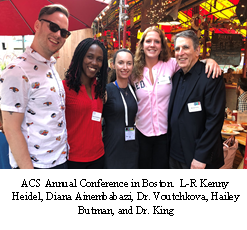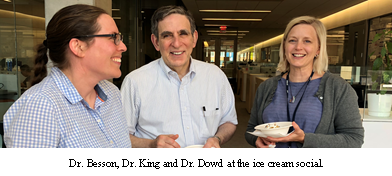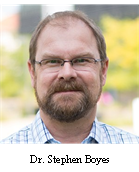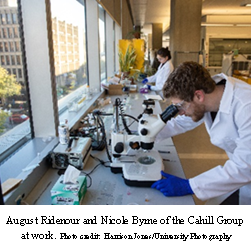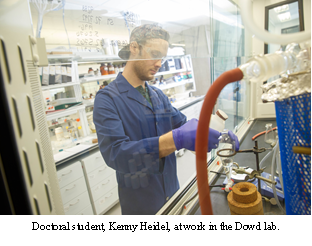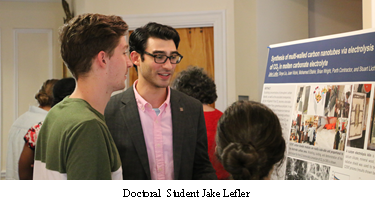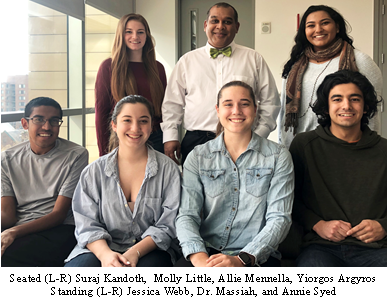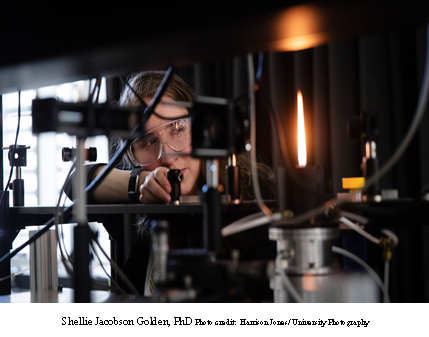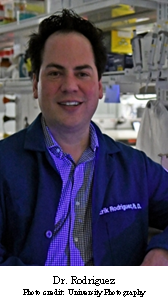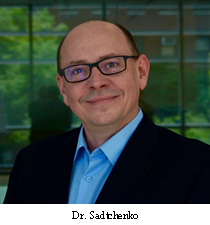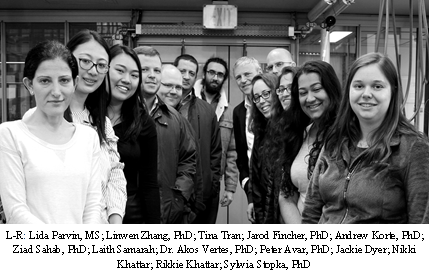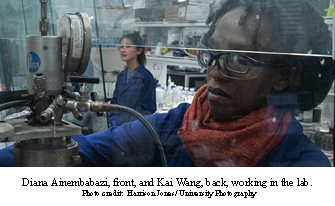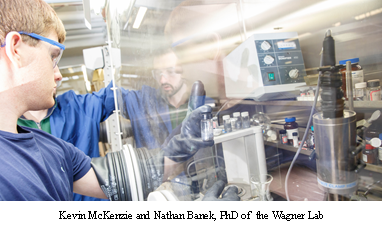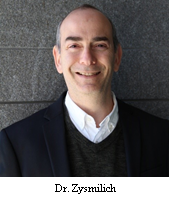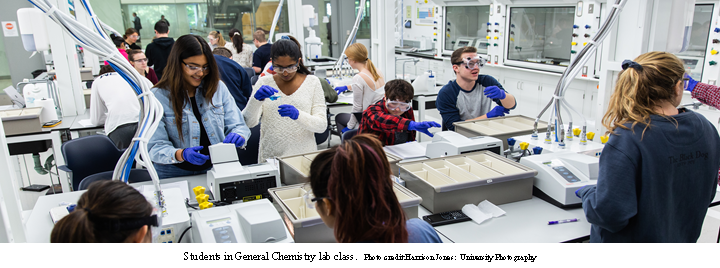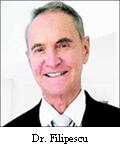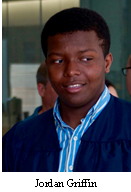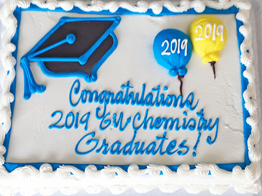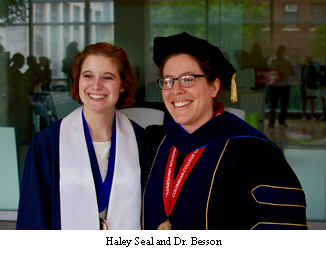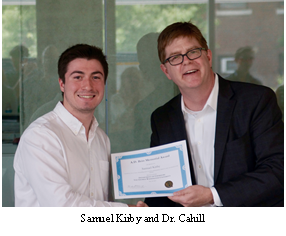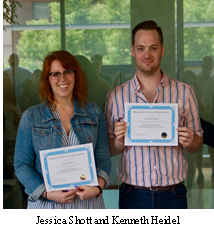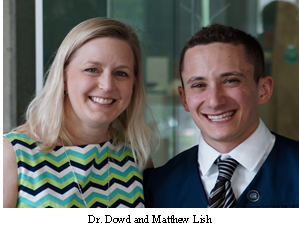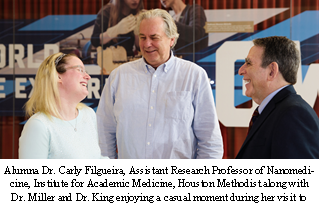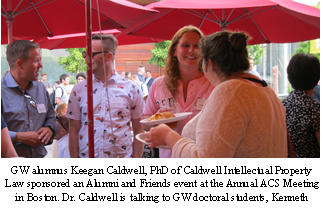Chemistry Newsletter, 2019
Message from the Chair
Department Spotlights
Student Updates
Alumni Updates/Class Notes
Letter from the Chair, Michael King
It has been my honor and great pleasure to write this column for the past 23 years. Therefore, it is a bittersweet time to share with you news that I stepped down as chair at the end of June and will retire at the end of the 2019-2020 academic year. It has been my honor and great pleasure to write this column for the past 23 years. Therefore, it is a bittersweet time to share with you news that I stepped down as chair at the end of June and will retire at the end of the 2019-2020 academic year.
I began my academic career in August of 1970 at NYU, following receipt of my doctorate earlier that spring. Thus, at the close of 2019-20, I will have been a member of a faculty for 50 years. Being in the academy has been a privilege and was always my life’s ambition. I am very proud of the papers I authored/coauthored, the research we have carried out, the students I have had the privilege to mentor and of course the many students who have learned organic chemistry in my classes. It has been an honor to have served GW, and I am humbled and grateful for the incredible honors bestowed on me for that service. Most especially, I am grateful for the privilege of representing my colleagues for over 20 years as chair of the chemistry department. My colleagues are brilliant, hardworking and engaging teacher-scholars. To be able to brag about them and our loyal, committed staff to others has been an incredible joy.
With your support and that of the administration, I have watched our department grow dramatically over the decades. This past year, we had close to 5000 students in our classes, awarded 11 doctorates and 21 Bachelor’s degrees. We expended close to $5 million in research funds from external awards, accounting for a bit over a quarter of the research expenditures in the college. During my tenure as chair, our faculty has grown by 50 percent, our graduate program has doubled and nine new endowed funds have been established to help to support our endeavors. I am most grateful to have played a part in that growth. Fittingly, we will shortly celebrate the 200th anniversary of the founding of the university and with it the 200th anniversary of this department. With the recent approval of a new strategic plan by the department, we are poised to move further as we move ahead in the new millennium.
Thus, it seems fitting to hang up the proverbial test tubes, and step aside for a new generation of leadership. I wish my successor, Chris Cahill, well as he takes on the leadership of the department and ask you to continue to connect and support our efforts.
Dr. Michael King
Chair and Professor of Chemistry
Department Spotlights
Undergraduate Research Symposium 2019
Design of Catalytic Ionic Liquids for Cellulose Hydrolysis Samantha Vaccaro, Selene Ramer and Jakub Kostal
Alcohol to Hydrocarbon Fuel via Catalytic Alcohol Coupling Diana Ainembabazi, Christopher Reid and Adelina Voutchkova-Kostal
Highly Selective Synthesis of Chirally Pure Carbon Nanotubes Aidan Canning and Claire Besson
Characterizing MID1-RNA Binding in Huntington’s Disease Yiorgos Argyros, Jessica Webb and Michael Massiah
Catalytic Transfer Hydrogenation of Biomass Derived Levulinic Acid Evan Sandefur, Keira Culley and Adelina Voutchkova
Synthesis and Characterization of Non-magnetic Analogs of Spin Crossover Molecular Quantum Bit Candidates Elliot Heywood, Chenyang Ma and Claire Besson
Cutting a cancer-related protein in half and re-ligating it to identify its role in hormone-inducible breast cancer Annie Syed and Michael Massiah
Synthesis of Goblet-shaped Tricyclopentadienyl Lanthanoid Molecules Haley Meyers, Ganesamoorthi Ramar, Maegan Dailey and Claire Besson
Using E. coli bacteria to produce proteins for functional studies Suraj Kandoth, Molly Little, Michael Massiah and Jessica Webb
High Capacity Selenium/Carbonaceous Composites for Li-Ion Cathodes Dustin T. Abele, Austin J. Pyrch and Michael J. Wagner
Novel Small Molecule Design and Synthesis to Selectively Inhibit Dxr and Combat Malaria and Tuberculosis G. Logan Bartholomew, Richard V. Beck, Kenneth M. Heidel, Rachel L. Edwards1, Audrey R. Odom John1 and Cynthia S. Dowd
New Faculty Spotlight
Organic Chemistry
We are delighted to welcome Professor Stephen Boyes to the department as an associate professor, filling the open position in chemistry for organic materials. Professor Boyes joins us from the Colorado School of Mines where he grew a program in polymer and material science, which is currently supported by an National Science Foundation grant. He focuses on specific polymeric materials that are “attached to” or “attached from” nanomaterial scaffolds. This research has application with materials employed as imaging agents for clinical use in cancer detection and bone tissue engineering and with the development of polyaramide brushes for membranes used in the aerospace industry, fuel cells and reverse osmosis. His papers have been published in high impact journals in his field, with a number appearing in Macromolecules and Biomacromolecules. With six patents (issued and applied for), he has also demonstrated that he can translate his cutting-edge research into practical tools of value to society. Professor Boyes is also a superb educator, having been voted an Outstanding Undergraduate Teaching Award for 2015-16 by the chemistry majors at his institution. His record of mentoring undergraduate and graduate students is likewise superb and extensive. We are thrilled that he has led some NSF REU programs and is planning on replicating that success at GW. Please join us in welcoming Professor Stephen Boyes to our family.
Analytical Chemistry
We are also pleased to welcome Dr. Ling Hao to the department as a new assistant professor filling our slot in bioanalytical chemistry. Dr. Hao is joining us from a postdoctoral position at the National Institutes of Health, where she has been learning the skills of cell biology from Dr. Richard Youle and Dr. Michael Ward, while using her background in mass spectrometry and proteomics to uncover the molecular mechanisms underlying neurodegeneration. Dr. Hao pursued her doctoral degree in analytical chemistry in the School of Pharmaceutical Sciences at the University of Wisconsin at Madison under the mentorship of Professor Lingjun Li. Dr. Li is a renowned scientist in the field of mass spectrometry. With a cover page article in Analytical Chemistry and multiple first author papers from her work in the Li lab, it is no wonder that Dr. Hao received first prize in a poster competition and the Wisconsin Initiative for Science Literacy Thesis Award in 2017, the year of her degree. Using the tools of separation and analytical methodology, Dr. Hao will be expanding from the traditional protein analysis to a combination of proteomics and metabolomics to investigate protein control systems involved in neurodegeneration. Multiple “omics” approaches to the investigation of disease biology is becoming a tour de force in the field and Dr. Hao is situated in a position to be at the forefront of this revolution with her expertise and connections. Please join us in welcoming Dr. Hao to our community.
Faculty Updates
Besson Group
10 researchers worked in the laboratory over the past 12 months. This includes two highly motivated high school summer interns, Aya Zaraket and Zoë Valladores, referred to us by STEMship, an organization bringing STEM education and training opportunities to underrepresented and disadvantaged youth, as well as four brilliant undergraduates (Elliot Heywood, Haley Meyers, Aidan Canning, Hayley Seal), two fantastic graduate students (Chenyang Ma and Maegan Dailey), a tenacious post-doctoral researcher (Ganesamoorthi Ramar, who left the group in November) and (rarely!) the PI, Claire Besson.
284 distinct experiments and syntheses were run in the group over the same time frame. Lest our reader thinks us lazy, this included the acquisition of 1898 UV-visible spectra and yielded 12 new crystal structures.
12,436 miles were traveled by group members to present our results, using 66.5 square feet of posters and 175 minutes of presentations. Highlights of the year were the GRC conference on Conductivity and Magnetism in Molecular Materials in Rhode Island and the International Conference on Molecular Magnetism in Rio de Janeiro.
310,466 dollars were awarded by NSF to fund a project entitled "Goblet-shaped, lanthanoid-based molecular spin valves" for the next three years. Maegan Dailey will be the graduate student in charge of the synthesis of this new class of magnetic molecules with a strong potential in molecular spintronics.
Cahill Group
Greetings from the Cahill research group! The year of 2019, marks 19 years at GW and delivers some big news. We welcomed two new PhD students—Jordan Herder and Ben Walusiak. Each of these gents has had industry experience before matriculating in the PhD program, and I thus welcome their “real world” perspectives. They are deep in first year efforts—classes, teaching and trying to get some research done. Fortunately, they are motivated and eager to get some results.
Veteran members August Ridenour and Nicole Byrne have not been idle either. August spent last summer at Los Alamos National Laboratory where he was working on new detection capabilities for nuclear forensics efforts. Productivity is high at GW, too, where he is helping get the new folks up to speed and mentoring undergraduate Connor Evans. Nicole will participate in another summer experience at Pacific Northwest National Lab where she will work with Cahill group alum Gian Surbella (PhD ’18) on the synthesis of transuranic element analogues of her uranium work that she does here in DC. Looking forward to those results from the frontier of the periodic table!
Chris has been in constant motion. Summer 2018 marked GW’s first Boot Camp on Nuclear Security Policy, which Chris ran along with colleagues from GW’s Elliot and Law schools. This truly interdisciplinary effort was funded by the National Nuclear Security Administration and aims to develop policy cognizance amongst technical PhD candidates. This was a grand success and featured TWO WEEKS of speakers, table top exercises, field trips and communications training for some 20 students from around the U.S. and abroad. We are in the trenches for 2019’s offering as we speak.
On the laboratory front, the last year produced about seven papers including some with our international collaborators in Jamaica, the U.K. and Brazil. We continue to be rather productive on the entire f-block with papers on both lanthanide and actinide materials. As a consequence, Chris has been in demand for speaking engagements with invited talks at the International Conference on f-elements in Lausanne, Switzerland, departmental seminars at Juniata College, Clemson University and Washington State University as well as the northwest regional ACS meeting at Pacific Northwest National Lab.
Perhaps the biggest news, however, is that Chris has been named chair elect of the chemistry department. This also means that Michael King will be stepping down as chair after a long and tireless spot at the helm. Chris is up for the challenge owing to his faith in his colleagues, the trajectory GW is on and a very healthy strategic planning process that he spearheaded with Professors Dowd, McClary and Massiah. Spring of 2019 has him very busy gearing up for the role, which becomes official as of July 1.
Dowd Group
Another fun and productive year in the Dowd group! In early 2018, we said congratulations and goodbye to two graduate students. Dr. Xu (Jack) Wang (PhD) did a short postdoc at Brown University and has started a career in the pharmaceutical industry. Mr. Ruiqin (Steve) Wang (MS) headed to the University of Minnesota in the fall to join their PhD program. In the fall, we welcomed first year doctoral student Ms. Dee Bague to the group! The Dowd group now has three doctoral students, one postdoc, and four undergraduates. Papers, presentations, and collaborations (in the U.S. and abroad) continue to fuel our research. Our work continues to focus on new antibiotics against tuberculosis and malaria. We are also expanding to investigate other organisms such as Staphylococcus aureus and other Staph species. Cindy is looking forward to the TB Gordon Conference this summer in Spain to share our work. In addition to research, Cindy continues to serve as chair of the CCAS dean’s council and as chair of graduate admissions for chemistry.
Kostal Group
The group has published its first independent and seminal publication on developing a new approach for designing safer chemicals. It was inspired by technologies in computational drug discovery and was funded by the PhRMA foundation. The article was published in RSC Green Chemistry was featured on the journal cover and included postdoctoral, graduate and undergraduate student contributions. We are presently extending our approach to other chemical classes and toxic endpoints, such as pesticides or ionic liquids used for biomass processing, a project that was recently funded by the National Science Foundation. Aside from our method development work, we continue supporting research projects of our academic collaborators at Baylor University, Yale and University of Washington, which focus on topics such as oxidative stress and ecotoxicity of commercial chemicals, which have resulted in publications in Chemical Research in Toxicology and Science of the Total Environment. Furthermore, we have ongoing collaborations with companies and NGOs vested in developing novel platforms for hazard and alternatives assessments, which would incorporate our uncertainty scoring system to assess quality in experimental and predicted toxicological data. For her work on predicting ecotoxicity of high volume pesticides, Selene Ramer, a junior chemistry major in the group, has won the coveted Joseph Breen Memorial Fellowship Award in Green Chemistry, and was invited to give a talk at the 2019 ISGC Symposium on Sustainable Chemistry Research and Innovation in La Rochelle, France. Preston Griffin, a first year graduate student in the group, was invited to attend the ACS Summer School on Green Chemistry & Sustainable Energy, where he will present our work on novel pesticide design. Dr. Traci Clymer, has departed our group to join Professor Gilbertson’s group at the University of Pittsburgh as a postdoctoral associate. Dr. Clymer was instrumental to our method development efforts, and present her work at the 2018 Drug Safety Gordon Research Conference at Stonehill College, MA. Samantha Vaccaro and Amanda Chen have joined our group as undergraduate researchers, and have begun work on their respective projects on cellulose hydrolysis by ionic liquids and in silico-in vitro testing of novel pesticides, in collaboration with the Dowd and Ramos labs at GW.
Licht Group
Carbon XPrize Finalist Team Licht:
This has been another productive (and exciting year!) for the Licht group. The group has new members including postdoctoral fellow Xirui Wang and Boris De Leon, while Mohamed Eltahir is now full time with group. All team members including Juan Vicini, Brian Wright and doctoral students Xinye Liu, and Jake Lefler are contributing in various capacities to our ongoing Carbon XPrize finalist team activities to combat climate change by transforming the greenhouse gas carbon dioxide into the most valuable product. The group is also participating in ongoing new molten air battery and ARPA-E (US DOE) projects based on our STEP process to form ammonia (widely needed for fertilizer) from air and water and without CO2 emission. Xinye Liu will be presenting her ammonia advances with an invited talk at this spring’s Electrochemical Society meeting, and Professor Licht was honored this year as an Electrochemical Society Fellow.
Massiah Group
The Massiah group continues its tradition of hosting several talented undergraduate students tackling challenging projects associated with human health. Senior undergraduate Yiorgos Argyros is independently working on RNA synthesis and purification to perform MID1–RNA binding interaction for a project focusing on fighting Huntington’s Diseases (HD). Yiorgos was awarded the prestigious Luther Rice Scholarship to do research in the lab during the summer of 2018; he will be pursuing a PhD at Weill Cornell Medical School in NYC. Senior undergrad Annie Syed is working on bioengineering a protein as two halves that can be produced separately but then be relinked by another enzyme: focus on studying structural changes half a protein at a time by NMR and isotopic labeling. Annie is pursuing a post-baccalaureate degree at Tulane University. Three undergrads at the freshman and sophomore levels joined the lab and are learning valuable biotechnology skills. Molly Little was awarded the Madeline Jacob fellowship to work in the lab during the summer of 2019. Jessica Webb is a new graduate student who joined the lab in the fall of 2018. She is working on characterizing protein-protein interaction associated with a project to redesign an enzyme to have greater activity. Professor Massiah also secured funding from the National Science Foundation for the next three years, and internal seed-funds from GW for Annie’s project. A chapter entitled, “Zinc-binding B-box domains with RING folds serve critical roles in the protein ubiquitination pathways in plants and animals” has been published in the online book Ubiquitin Proteasome System - Current Insights into Mechanism Cellular Regulation and Disease.
McClary
Dr. McClary is finishing her seventh year in the chemistry department. She was an integral member of the department strategic planning committee along with Drs. Cahill, Dowd and Massiah, Mr. Greg Thomas, and graduate student Dustin Abele. She continues to serve as the department program coordinator for the GW learning assistants program. Twelve undergraduates facilitated active learning and deeper engagement in General Chemistry and Organic Chemistry, impacting approximately 500 students this academic year. At the end of school year, Dr. McClary concluded her formal role as a Posse (group) mentor. She will continue to mentor her ten scholars informally and looks forward to their continued growth as scholars and leaders. In her spare time, Dr. McClary enjoys hosting general chemistry review sessions, running and decorating cakes.
Miller Group
During the 2018-2019 academic year, both Michelle Bailey and Shellie Jacobson Golden completed and defended their dissertations. Michelle’s dissertation described a topic previously reported here on the development and deployment of an Open Path laser absorption instrument for measuring CO2 and CH4 emissions from thawing permafrost. (One of our instruments is now being modified for use at the Smithsonian Environmental Research Center in the dissertation work of Monica Flores.) Also in the atmospheric arena, we won a DOE award with Mesa Photonics of Santa Fe, New Mexico that will use laser heterodyne radiometry to profile water vapor in the troposphere.
Shellie’s dissertation describes her characterization of the optical extinction properties of “black” and “brown” carbon throughout the visible, near- and mid-infrared bands using several laser sources. She also completed a new study of laser-desorption mass spectrometry that reveals the molecule specific composition of particulate carbon formed in flames. Andrew Kamischke recently joined the group and will be working on NSF-funded studies of polynuclear aromatic hydrocarbon laser-induced fluorescence using a new optical parametric oscillator source that operates from 210 to 2400 nm.
Katie Hinnant continues to develop a test article for evaluating environmentally friendly, foaming agents for extinction of liquid pool fires in a project funded by the Naval Research Laboratory. She is introducing a new, rapid response measurement of carbon dioxide in the fire’s effluent using diagnostics developed in our laboratory. Finally, Jennifer Giaccai won a Smithsonian Scholarly Studies Award titled “Distinguishing Chinese Inks with Raman Spectroscopy” that allows her to combine her experience in laser-based carbon diagnostics with the interests of the Freer Gallery in establishing provenance for Asian Art.
Rodriguez Group
The lab is fully functional and performing research with collaborators around the world. In Summer 2018, three undergraduates worked in the lab, including Justin Hachey (GW), Jack Conlon (GW), and Angelo Walker (GW SPARC, N. Carolina Agricultural & Technical State University). The GW Summer Program Advancing Research on Cancer (GW SPARC) engages diverse undergraduates in a mentored summer research experience. Three grants were awarded this year, including the Columbian College Facilitating Fund (CCFF), Cross-Disciplinary Research Fund, and GW Cancer Center/Katzen Pilot Award. The CCFF and GW Cancer Center/Katzen Pilot Award support new tools for imaging cancer with fluorescent protein nanoparticles and fluorescent personalized drug screens. The Cross-Disciplinary Research Fund was awarded with Vesna Zderic (School of Engineering & Applied Sciences, Department of Biomedical Engineering) and Mary Ann Stepp (School of Medicine & Health Sciences, Departments of Anatomy & Regenerative Biology & Ophthalmology) for ultrasound-enhanced delivery of macromolecules for treatment of ocular diseases. Erik presented at the GW Nanofabrication & Imaging Center (GWNIC) Correlated Light & Electron Microscopy Workshop (DC), Fluorescent Proteins & Biological Sensors VI (Janelia Research Campus, Ashburn, VA), and The International Meeting on Optical Biosensors (Ghent, Belgium). Erik is speaking at the 2019 BRAIN Initiative Meeting (DC), the 14th International Conference on Tetrapyrrole Photoreceptors in Photosynthetic Organisms (Sidney, AU) and the University of Tasmania (Hobart, TAS). A paper was submitted, which developed a genetically encoded, non-immunogenic system for imaging genetically modified CRISPR/Cas9 or CAR T cells in humans. Three manuscripts are being prepared for submission. The Rodriguez Lab won the 2018 #RealTimeChem Week award for #BioChem and the 2018 Annual #Chemistree Competition in Category 2 for mentioning the use of elements, Europium, both sponsored by the Royal Society of Chemistry. More information at Dr. Rodriguez's website.
Sadtchenko Group
A major article was published on March 5th, 2019 by the Journal of Chemical Physics. The article was titled “Glass softening kinetics in the limit of high heating rates” and authored by Ulyana C. Cubeta and Vlad Sadtchenko. The manuscript, which is based on a chapter from Dr. Cubeta’s PhD dissertation, describes the novel theoretical analysis of the Fast Scanning Calorimetry measurements. Our theoretical approach facilitates inferring extensive and quantitative insights into ultraslow molecular dynamics in glasses and other amorphous solids from experimental tests with durations of only a few milliseconds. Since Dr. Cubeta’s graduation from the GW Chemistry PhD program, this groundbreaking research is carried on by another graduate student, Rinipal Kaur, who has successfully passed her PhD candidacy exam. Sadtchenko’s group also welcomes an undergraduate researcher, Qene Mahlet, who joined the ongoing research activities in January 2019.
The GW Chemistry Department Wishes Dr. Teng a Fond Farewell
We bid a fond farewell to Professor Henry Teng who retired from GW and accepted a position at Tianjin University. Professor Teng spent nearly 20 years at GW. He started as a professor in the geology department, moving to chemistry when the department disbanded. He served as director of the environmental and resource policy program, and later, he was an adviser for the chemistry department's environmental and green chemistry program. Professor Teng is currently a professor in TJU's Institute of Surface Earth System Science and an emeritus professor at GW. We greatly miss Professor Teng, and we wish him luck on this new adventure.
Vertes Group
Collaborative interdisciplinary work continues to dominate our research. At the frontier of nanophotonics and analytical chemistry, Drs. Sylwia Stopka and Andrew Korte, in collaboration with researchers at the Oak Ridge National Lab, explored the utility of new silicon nanostructures for ultra-trace analysis. Working with invertebrate neurobiologists in Hungary, Dr. Linwen Zhang discovered a new neuropeptide by analyzing the cytoplasm of a single neuron in the great pond snail. In a joint project with colleagues from the Pacific Northwest National Lab and the University of Missouri, our team described the metabolic processes involved in biological nitrogen fixation with single cell resolution. Working with a medical team, a senior graduate student in the group, Jarod Fincher, utilized our nanophotonic ionization platform for the imaging of bacterial lipid distributions in chronic wounds. All these activities are carried out against the backdrop of a major three-way collaboration with SRI International and GE Global Research to develop methods for the rapid molecular assessment of a chemical or biological threat.
As the established members of our team are reaching new heights in their career, last year there were two new additions to the Vertes Group. Sara Mattson joined the group to work toward a doctoral degree, and with a scholarship from the Brazilian government Gessica Vasconcelos arrived for a year filled with learning and research. During her stay, Gessica decided to pursue a doctoral degree from the graduate program of the department of chemistry at GW. Two long-term undergraduate researchers, Tina Tran and Ellen Wood, are also making significant contributions. Along with the rest of the group, they will present their work at an upcoming national meeting of the American Society for Mass Spectrometry.
Voutchkova-Kostal Group
The Voutchkova group continues research on the development of processes to transform waste products, like CO2 and glycerol, to valuable chemicals, like formic and lactic acid, using supported catalysis. We have a new NSF project that started this year, in collaboration with the Kostal group, which aims to computationally design specialty solvents (ionic liquids) for safe and effective ways of breaking down non-edible plant material (lignocellulose) to valuable chemicals. Lastly, we are also pursuing DOE funding to continue work on an exciting method for turning renewable alcohols to long-chain hydrocarbon fuels. We welcomed a new MS/PhD student to the lab, Rebecca, and bid farewell to a postdoc Dr. Jacob Heltzel, who recently joined Merck Process Chemistry division.
Wagner Group
The lab welcomed two new members, Jessica Schott, who is working on multimodal MRI contrast/cancer therapeutic nanoparticles, and Michael Womble, who is conducting his research on carbon nanochains. Kevin McKenzie and Dustin Abele are continuing their PhD studies and Nathan Banek won a very prestigious IC postdoctoral fellowship. The highlight of our research was the publication of “Sustainable Conversion of Lignocellulose to High-Purity, Highly Crystalline Flake Potato Graphite,” which was named an “editor’s choice” (making download free), a cover article and was highlighted with a story in C&E News (Making Sustainable Battery Electrodes from Sawdust).
Zysmilich
Professor Zysmilich has been teaching the very popular Contemporary Science for Non-Science Majors courses (Chem 1003 and Chem 1004) for the past 19 years. He also teaches General Chemistry II (Chem 1112) and Organic Chemistry I (Chem 2151).
Professor Zysmilich serves as an advisor of undergraduate chemistry majors, and as the director of graduate studies for the chemistry department, duties of which include recruiting of new graduate students, keeping our research active graduate students on track and helping to define programs of studies. In October 2018, Professor Zysmilich participated in the graduate school and recruiting fair at the Southeastern Regional Meeting of the American Chemical Society in Augusta, GA. He is also a member of the university formal grievance hearing committee.
In February 2019, Professor Zysmilich participated in Expedición Ciencia Panamá, discovery-based science camps for high school students, sponsored by the Fundación para la Promoción de la Excelencia Educativa.
In Memoriam
This February we said goodbye to Professor Emeritus Nicolae Filipescu. Professor Filipescu came to the U.S. as a refugee from Romania in 1959 and settled at GW, receiving a doctorate from Professor William Sager in 1964. He was already serving on the faculty when he completed his degree and rose quickly to the rank of professor of chemistry by 1970. While educating many generations of students, he published over 70 papers and received the Hillebrand Prize from the Chemical Society of Washington for outstanding work in photochemistry and intramolecular energy transfer. For many years, he taught the graduate course on Organic Chemistry and beginning in 1970, our Contemporary Science (Chem 1003-4) course, a class he developed to serve as a general education chemistry course for non-science majors. The course started out in the early days with about 25 students enrolled per semester, but grew to enrolling over 500 students each semester. The course is still taught today. During his tenure on the faculty, Professor Filipescu also earned his MD degree in 1975, eventually being appointed concurrently as a clinical professor of obstetrics and gynecology at the Medical School. In 1982, he held a Fulbright Fellowship in his native Romania, where he taught genetics, obstetrics and gynecology. Professor Filipescu retired from the chemistry department in 2000, but he continued his medical career, serving on the Inova Fairfax Medical Center Staff for 40 years. “He truly was an example of a lifelong learner. He kept current not only in medicine but also in science and technology,” said Professor King. “He was a true example of devoting his life to those and that which he loved. He will be remembered fondly by the GW chemistry department.”
Student Updates
2018-2019 Graduates
PhD in Chemistry
Camille Lombard Banek, PhD, August 2018-Currently a post doc at the University of Maryland but has accepted an NRC fellowship for a post doc at NIST.
Michelle Bailey, PhD, December 2018-Scored a rare “A”rating on the National Research Council Postdoctoral Review application and was offered a NRC position at NIST.
Rachelle Jacobson Golden, PhD, May 2019-Has accepted a post doc in lipidomics at Sanofi in Waltham, MA.
MS in Environmental and Green Chemistry
Savannah Sierco, MS, May 2019-Plans on staying and working in D.C.
Steven Woolford, MS, May 2019-Will pursue a PhD in Chemistry at the University of Maryland.
BA/BS in Chemistry
Aidan Canning, BS, May 2019-Will pursue a Biomedical Engineering PhD at Duke in the TuanVo-Dinh Lab.
Kusuma Devi Alaparthi, BS, May 2019-Considering options in the industry.
Mia Dortenzio, BS, August 2019-Plans on combining her love of the arts and chemistry by getting a master’s degree in art conservation.
Jordan Griffin, BS, May 2019-Pursue an occupation in patent law, followed by law school for IP law.
Helia Imany-Shakibai, BA, May 2019-Currently working as a clinical research assistant at GW Hospital and will begin medical school in August at UCLA.
Emily Ivers, BA, May 2019-Begin law school in the fall to study pharmaceutical patent law.
Tabinda Kahn, BS, May 2019-In the summer Tabinda will work as a health assistant for Johns Hopkins University and volunteer as an EMT. In the fall Tabinda will do clinical research for substance abuse at Mass. General and work as a volunteer EMT/Firefighter.
Matthew Lish, BS, May 2019-Will attend graduate school for Organic Chemistry at University of Wisconsin-Madison. After his graduate degree, he plans on working in industry.
Austin Pyrch, BS, May 2019-Will work in the biotech industry for a year before applying to a PhD program.
Caroline Racke, BS, May 2019-Pursing an MPH in Public Health Nutrition at GW.
Samuel Rodriguez III, BS, May 2019-Plans on attending medical school after being a firefighter/EMT for a year and hopes for a part-time research position.
Erin Russell, BS, Dec. 2019-Currently is a Validation Technician at Medical Diagnostic Laboratories making certain that all tests run in the lab are valid and will work. She plans to attend graduate school in the future.
Evan Sandefur, BS, May 2019-Moving to California and applying to Medical School.
Hayley Seal, BS, May 2019– Plans on traveling across the country for a year prior to beginning her PhD in chemistry.
Jordan Tanen, BS, May 2019-Will begin research in the forensics lab and continue to pursue her MS in Forensics at GW.
Prizes and Awards
ALPHA CHI SIGMA: Awarded to the graduating senior with the highest academic record in chemistry courses.
MATTHEW LISH
AMERICAN CHEMICAL SOCIETY (Analytical): Awarded to a student completing the junior year, who has demonstrated excellence in Analytical Chemistry.
GEORGE LOGAN BARTHOLOMEW
AMERICAN CHEMICAL SOCIETY (Inorganic): Awarded to a student who has demonstrated excellence in inorganic chemistry at the undergraduate level and whose future plans include a career in chemistry.
CAROLINE RACKE
AMERICAN CHEMICAL SOCIETY (Organic): Awarded to a student who has demonstrated excellence in organic chemistry and whose future plans include a career in chemistry.
MATTHEW LISH
AMERICAN CHEMICAL SOCIETY (Physical): Awarded to a student who demonstrated excellence in physical chemistry and whose future plans include a career using chemistry.
UJWAL BODDETI
AMERICAN INSTITUTE OF CHEMISTS: Awarded to a graduating chemistry student who excels in scholarship, integrity and leadership.
Graduate — DIANA MICHELLE BAILEY
Undergraduate — HAYLEY E. SEAL
A.D. BRITT MEMORIAL, MADELEINE REINES JACOBS, AND CHARLES AND ELMA NAESER FUND: Awarded to one or more outstanding junior or senior undergraduate majors to carry out research in the summer.
MADELEINE REINES JACOBS FUND:
JUSTIN HACHEY, MOLLY LITTLE, SAMANTHA VACCARO, ANNA STEINER, MIREN LOPEZ LASCURAIN
A.D. BRITT MEMORIAL FUND:
GEORGE LOGAN BARTHOLOMEW, HALEY MEYERS, SAMUEL KIRBY
CHARLES AND ELMA NAESER FUND:
TINA TRAN
CHEMICAL SOCIETY OF WASHINGTON PRIZE: Awarded to the outstanding junior majoring in chemistry.
SELENE RAMER
BYRNE THURTELL BURNS MEMORIAL PRIZE: Awarded to the graduating chemistry major who has shown the greatest proficiency in organic chemistry as demonstrated by a written examination.
MATTHEW LISH and CAROLINE RACKE
WILLIAM E. FITCH PRIZE: Awarded to the graduating chemistry major with the best written comprehensive examination in chemistry.
CAROLINE RACKE
CHEMICAL RUBBER COMPANY FRESHMAN CHEMISTRY ACHIEVEMENT AWARD: Awarded to one or more freshmen who have achieved the highest records in their respective sections of Introductory Chemistry.
NUR BOOKWALA, ANGELINA POPILLIO, and LAYLA SERNA
BENJAMIN D. VAN EVERA MEMORIAL PRIZE: Awarded to the most effective Graduate Teaching Assistants in Chemistry.
KENNETH HEIDEL, JESSICA SHOTT and SAVANNAH SIERCO.
Alumni Updates
George Chang, BS ’82, is now a urologist at Medstar Washington Hospital Center in Washington, D.C.
Kaitlin Cowles, BS ’17, graduated with an MSEd from the UPenn Graduate School of Education through the Boarding School Teaching Residency at Miss Porter's School. She has accepted a full-time faculty position at Miss Porter's teaching chemistry and math.
George Chang, BS ’82, is now a urologist at Medstar Washington Hospital Center in Washington, D.C.
Kaitlin Cowles, BS ’17, graduated with an MSEd from the UPenn Graduate School of Education through the Boarding School Teaching Residency at Miss Porter's School. She has accepted a full-time faculty position at Miss Porter's teaching chemistry and math.
Scott Dantley, BS ’92, recently was hired by Howard University as the senior associate dean for academic affairs for the School of Education in 2018. He also earned tenure as a full professor of science education.
Colten Eberhard, BS ’17, will be starting a PhD in Pharmacology at Johns Hopkins in the fall.
Arthur Jason De Luigi, BA, BS ’97, is the chairman of the Department of Physical Medicine & Rehabilitation and Medical Director of Sports Medicine at Mayo Clinic Arizona.
John DeMember PhD ’68, after his PhD at GW, had the privilege of working on a postdoc with Dr. George A. Olah at CWRU 1968-70. They generated 25 JACS publications together and performed some of the seminal work leading to the 1992 Nobel Prize in Chemistry.
Vanessa Distabile, BS ’17, stayed at GW to earn her master's degree in forensic sciences, graduating in May 2018. She is currently employed by SURVICE Engineering Company working as a forensic analytical drug chemist under a government contract.
Miriam Edelstein BS ’55, remembers her fondest memory from GW being her physical chemistry teacher, Dr. Wood. Miriam is enjoying life and is happy to announce that her granddaughter just recently got married.
Nelson Ferreira, PhD ’82, is a practicing gastroenterologist in Hagerstown, Maryland, who also does sponsored clinical trials.
Larry Fertel, BS ’81, is acting research director at IsleChem LLC, a contract chemical research company specializing in process development and scale up of chemical processes. He does research in all areas of chemistry for a number of clients.
Philip George, BS ’10, after graduating with his degree in chemistry, went to medical school at GW and just finished his residency in general surgery at Mount Sinai Hospital in New York. He will soon start his fellowship in hernia and robotic surgery in Annapolis, MD.
Khalid Hanif, BS ’98, is currently at Thermo Fisher Scientific as a senior manager of R&D within the clinical sequencing division. He works on development of NGS cancer diagnostic assays for both FFPE and liquid biopsy samples.
Jennifer Herdman, PhD ’12, has been teaching HS science for the last few years and will be taking a position as a lecturer teaching physical chemistry and first year chemistry at Western Colorado which is a public liberal arts school with a strong environmental science emphasis. She is also first author on some high impact journal articles which have been transformative in both combustion diagnostics as well as modeling of nanoparticle formation in flames.
Madeleine Reines Jacobs, BS ’68, leads Strategic Science, a consulting firm providing organizational consulting, project design and communication/writing services to scientific organizations. She chairs the GW Board of Trustees Committee on Academic Affairs and was recently elected a Fellow of the American Chemical Society.
Atul Jani, BS ’82, is in his 29th year of private practice in general surgery. He lives with his wife and two children in Salinas, California. He fondly remembers his classes and labs at Corcoran Hall.
Jack Kaplan, BS ’70, practiced radiology for 25 years at Baptist Hospital in Miami and is now retired spending his summers in Lake Toxaway, N.C. He enjoyed a second career in real estate development throughout Florida after he retired from medicine.
Randall Kaye, BS ’84, is currently the chief medical officer at Click Therapeutics. His daughter, Alyx, was accepted early decision to GW this past year. Dad is hoping she majors in Chemistry, although she seems most interested in studying history.
John A. McLean, PhD ’01, is Stevenson Professor of Chemistry at Vanderbilt University. Dr. McLean completed his PhD at George Washington University in 2001, where he made significant contributions in plasma spectrochemistry in the development of new technologies for the analysis of complex and limited radionuclide and biological samples. Dr. McLean was recently appointed Chair of the Chemistry Department at Vanderbilt.
Alexander Moran, BS ’14, has been working and focusing on global public health, specifically within infection control and drug safety related to HIV and Tuberculosis. He is set to begin his PhD in epidemiology at UCLA in September.
Al Nadel, BS ’71, retired in January 2018 after 45 years in the patent profession, from his intellectual property firm he co-founded. Since then, travel has been his main enjoyment, including Antarctica in December 2018. Next up: the Arctic in April 2020!
Nick Ryan, BS, MS ’16, during his gap year, Nick worked in the emergency department at the Massachusetts General Hospital. This summer, Nick will be entering medical school at the University Of New England College Of Osteopathic Medicine (class of 2023).
Jenna Sartucci, BS ’16, is currently working on a PhD in chemistry at Georgetown University. She works in the Gavvalapalli group doing polymer and organic synthesis.
Mike Waldman, BS ’87, has been lab director at Eutech Scientific Services, an analytical laboratory specializing in pharmaceutical and medical device testing. He is currently living in the Lehigh Valley.



